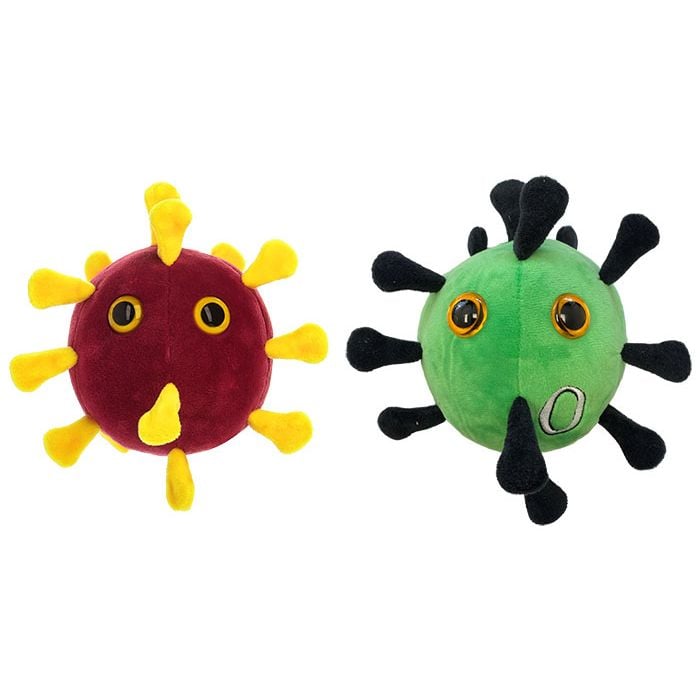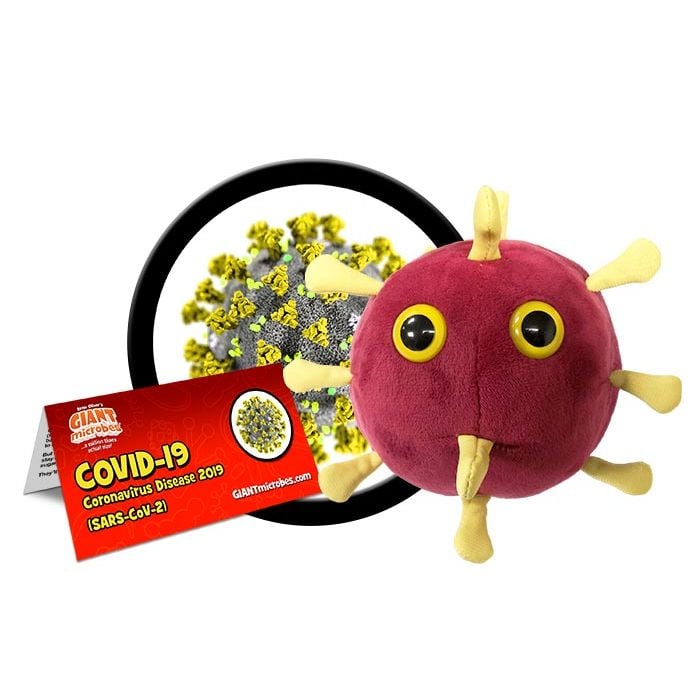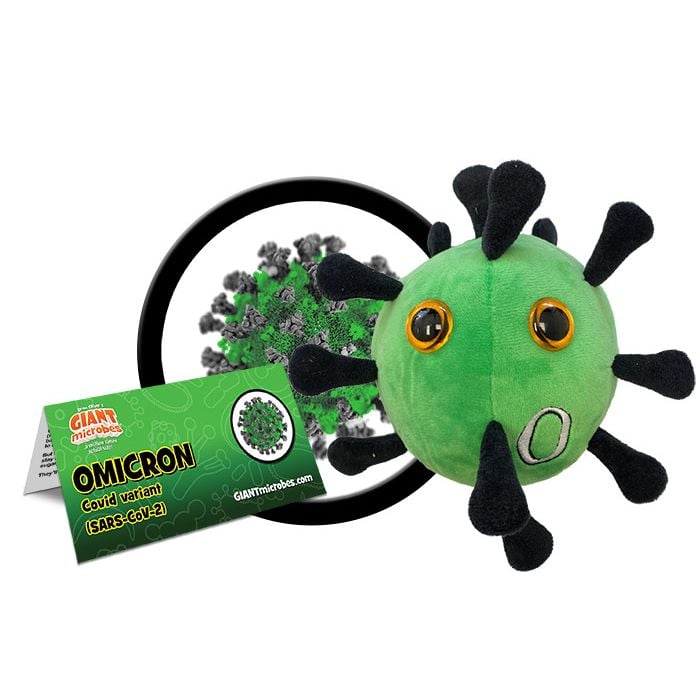Omicron Covid 2-pack
Out of Stock
This special edition GIANTmicrobes 2-pack is an engaging and hands-on gift for students, teachers, scientists, healthcare professionals and anyone with a healthy sense of humor!
The Omicron surge brought with it a potent fast-moving wave of Covid infections across the globe. This variant is still potentially lethal, but fortunately tends to cause severe illness less often than earlier strains of the coronavirus.
Decorate your home, lab, class or office. An engaging gift for the whole family, students, teachers, scientists and anyone in healthcare.
Includes both Omicron and Coronavirus COVID-19 plush and comes with information cards.
Size for each: 6 x 6 x 6"
Product Details
Additional Information
| Sizes | Giantmicrobes are based on actual microbes, cells, organisms and other critters, only 1,000,000 times actual size! Gigantic (GG) 16-24" XL (XL) 10-15" Original (PD) 5-8" Keychain (KC) 2-4" with clip |
|---|---|
| Materials | Plush from all new materials. Stuffed with polyester fiber fill. Surface washable: sponge with water & soap, air dry. |
| Packaging | Each plush microbe includes a printed card with fun, educational and fascinating facts about the actual microbe or cell. |
| Safety | Every product meets or exceeds U.S. and European standards for safety. For ages 3 and up. |
All about Omicron Covid 2-pack
FACTS: Cities are locked down, schools and businesses are closed, economies quiver and thousands of people are quarantined. The World Health Organization declares a global pandemic. This is the face of the coronavirus disease named COVID-19.
Identified in 2019 in China, COVID-19 quickly spread around the world during 2020. Spreading along with it: confusion, rumors and fear. Even in 2021, much about this virus remains unclear. Compared to the seasonal flu, COVID-19 is more contagious and has a higher fatality rate. Scientists and public health experts scramble to confront it with 21st century therapies and vaccines. Meanwhile, governments “go medieval” by closing borders and isolating citizens inside their tainted towns. What should you do when a mysterious microbe comes knocking and the threat of a modern day plague is in the air? Start by staying calm and learning the facts.
The name COVID-19 stands for coronavirus and disease. Corona is for its crown-like protein spikes. The virus itself is named SARS-CoV-2. Coronaviruses are zoonotic, jumping from animals to humans. Many originate in bats. SARS was transmitted by civets, MERS by camels, and COVID-19 likely by animals sold in wildlife food markets. With contagious microbes, you are often at the mercy of nature and the interconnectedness of our world.
COVID-19 spreads from person-to-person through respiratory droplets carried in coughs or sneezes. It may also be transmitted by touching your mouth, eyes or nose after touching contaminated metal, plastic and other hard surfaces on which a virus can survive the longest. People are most contagious when showing signs of sickness, yet the virus can spread before symptoms occur. Symptoms may appear 2 to 14 days after exposure and can include loss of smell, fever, cough and shortness of breath. Some have no symptoms at all. The best way to prevent illness is to minimize exposure with common-sense measures. Avoid close contact with people who are sick. Do not touch your eyes, nose and mouth. Stay home when sick. Cover your cough and sneeze with a tissue. Disinfect frequently touched surfaces. Wash your hands often with soap and water. Wear a face mask to help protect yourself, protect others and slow the spread of COVID-19.
Microbes are remarkable and mostly good - vital to our bodies and our planet. However, when it comes to the struggle against flu, measles, black death, malaria and other infectious diseases such as COVID-19, it is human wits versus microbe genes. If we want to triumph, we must think clearly, learn, prepare and respect the microbial world.
The Omicron surge brought with it a potent fast-moving wave of Covid infections across the globe. During the fall of 2021 and winter of 2022, the Omicron variant accelerated the pace of sickness and death. Fortunately, the Omicron variant, though still potentially lethal, tends to cause severe illness less often than earlier strains of the Covid virus. Yet because of the sheer number of cases, hospitalizations still rose to record levels. Omicron is very good at infecting the upper respiratory tract, making it so contagious. It is not as good at infecting the lungs, so it is less virulent.
Identified in 2019 in China, Covid-19 quickly spread around the world during 2020. Spreading along with it: confusion, rumors and fear. Even in 2021, much about this virus remains unclear. Compared to the seasonal flu, Covid is more contagious and has a higher fatality rate. Scientists and public health experts scramble to confront it with 21st century therapies and vaccines. Meanwhile, governments close borders and isolate citizens. What should you do when a mysterious microbe comes knocking and the threat of a modern day plague is in the air? Start by staying calm and learning the facts.
The name Covid stands for coronavirus and disease. Corona is for its crown-like protein spikes. The virus itself is named SARS-CoV-2. Coronaviruses are zoonotic, jumping from animals to humans. Many originate in bats. SARS was transmitted by civets, MERS by camels, and COVID-19 likely by animals sold in wildlife food markets. With microbial diseases, we are often at the mercy of nature and the interconnectedness of our world.
The Covid virus has repeatedly surprised scientists, mutating rapidly and accelerating when experts though it would ebb. The future of this pandemic depends on the virus and how we wield our arsenal of vaccines, ventilation, masks, treatments and public health measures. When it comes to the struggle against flu, measles, Covid and other infectious diseases, it is human wits versus microbe genes. If we want to triumph, we must think clearly, learn, prepare and respect the microbial world. Covid may become an endemic disease, indefinitely circulating at some level and becoming a routine fact of life. When this chapter of the Covid story will begin is yet to be determined.







